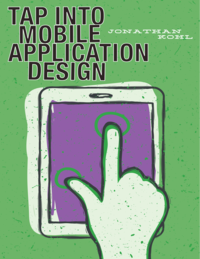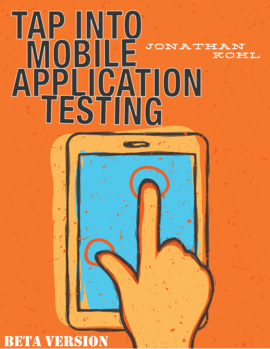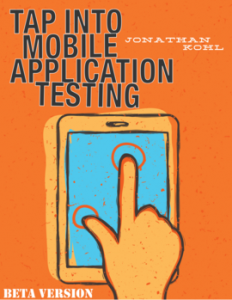After a long delay due to some health issues, I have finally finished the first version of Tap Into Mobile Application Design. This book is only available in PDF and epub electronic formats which should work on most e-reader apps on most mobile devices. I used Leanpub as the publishing platform, as with Tap Into Mobile Application Testing. I like this platform because it’s faster for me to get content out there, changes and updates are instant, and customers can download updated copies for free.
This book is long and detailed, a result of me trying to capture most of my thoughts on designing software for mobile apps. When I started the book, I had planned for something much shorter, but as I worked through the content, it felt abbreviated and overly simplified. In Tap Into Mobile Application Testing, I made a couple of mistakes trying to overly simplify complex technical issues with regards to wireless technology. I updated some of the content to be more accurate, but I didn’t want to repeat that problem with this book, so I went deeper in some technical areas.
To help illustrate the challenges we have on these projects, I decided to use an example app project in the book. This helps to ground the content, moving from initial idea, to a full user experience design process and ending with user testing. The example project helps illustrate what a real world project can look like, but with the benefit of time I was able to capture many design project issues, rather than the few you encounter on a rapidly developed app. You get it all, including the positives and the negatives of the example app.
Furthermore, the context of app design changed as I was writing, and I felt I should capture some of those changes in the book as well. The legal landscape has changed, and there is a much better awareness of ethics and the long term effect of our designs on people. With the benefit of a side project to use as the example in the book, I was able to capture these issues as they happened on that project. The project had to adjust, and that is reflected in the book. Unexpected issues are common on mobile projects, and the example app shows how we adjusted. Initial attempts often fail due to oversight, legal rulings have an impact, and the timing of what you do on a product is crucial.
The book is also longer because it doesn’t just follow a happy path. There are lots of great books out there that fit that model. Instead, this book covers false starts, changes in direction and a completely reworked interaction design. That’s right, I cover how we almost went to market with one design, hit a snag, and completely redesigned the example app from the ground up. It’s difficult to capture the non-linearity of design in a book, and that results in some awkward flow and a couple of extra long chapters. I apologize for that, but I had hoped this would be an honest and detailed account of what can happen when you are creating an app.
I have also created a book bundle, combining both my “tap into” books called Tap Into Mobile Apps, where you can buy both the books for about the same cost as the full price of either book. The books are very different, but are complementary. In Tap Into Mobile Application Testing, the reader follows Tracy, a tester who is learning about mobile testing approaches. In Tap Into Mobile Application Design, the reader follows an example mobile app project called “Reporter” throughout the book. The design book is more heavy and dense content-wise, and that is reflected in the tone. The testing book is lighter in content and tone and an easier read. Both books cover technical issues to help inform your work. The combination of designing for or testing for people in social contexts, with a deep understanding of the technical underpinnings of the technology, within real world environments is my core differentiator. When I help teams develop that three pronged approach themselves, they build better software and have happier customers.
Both of these books represent my approach to working on mobile apps, which people can utilize as they see fit. These books aren’t for everyone. They are long and detailed and don’t provide easy answers. What they do provide is context and details that are important to understand on mobile projects, especially when you are having trouble. In spite of it representing a more difficult approach to your work, Tap Into Mobile Application Testing has been used by people all over the world, and influenced many mobile projects. It was highly praised when released and even now people contact me to tell me about how much it helped them. People still use it, they still talk about it at conferences and on projects, and several years on, find it relevant and helpful. I hope as many people find the design book to be as useful as they found the testing book.


